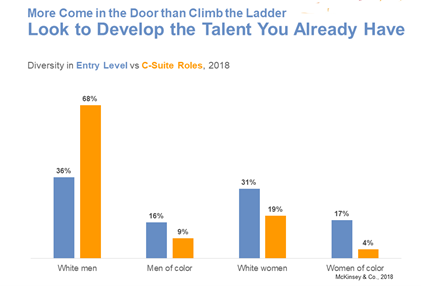Articles
War for Talent: Upskilling for Diversity, Equity, and Inclusion
- By Brooke Ballenger
- Published: 6/22/2021

Lifelong learning and professional development are integral parts of the employee experience, so why aren’t companies looking toward their own employees when recruiting for new positions? Upskilling talent from within an organization sets up a roadmap for underrepresented groups to advance and allows organizations to build a more diverse culture.
In a recent AFP webinar, “Your Hidden Gem Is the Talent You Already Have,” Jim Kaitz, president and CEO of AFP, moderated a discussion with Johnny C. Taylor, Jr., president and CEO of the Society for Human Resource Management (SHRM), and Matt Sigelman, CEO of Burning Glass Technologies, on the benefits of recruiting internally and strategies for identify existing talent that can have a positive impact on an organization’s diversity, equity and inclusion (DEI) initiatives.
Focus on DEI
For employers to make meaningful progress on diversity, equity and inclusion, they need to focus less on hiring, and more on creating escalators that are necessary to raise diverse talent up from within. “When businesses set their sights on the external talent market only, they are making the flawed assumption that the pool of diverse talent is fixed, and they are competing in a zero-sum game,” said Taylor. “Companies spend heavily on learning and development, but much of it is focused on systems or compliance training; relatively little is spent on helping workers move up.”
According to Taylor, businesses need to do at least five things to sustain a more diverse workforce:
- Track mobility, not just representation.
- Set actionable goals.
- Identify reservoirs of talent.
- Understand disparities and representation across roles, functions, business units, and locations to highlight opportunities to bridge between talent reservoirs and talent deserts.
- Assess the health of your pipeline.
“Know where your bench is thin to help you focus on areas of need and opportunity and direct your efforts on where to put resources to engage in this war for talent,” said Taylor. “Annual turnover is now the new normal, and this war is not going to abate within the next couple of months. Organizations must focus on what they can do to help their business be as successful as it can be in this sustained war for talent.”
The data
A lot of companies today feel like they have two problems: 1) a severe talent shortage, and 2) the need to build a diverse workforce. However, when looking at the talent within organizations and building escalators for talent to rise, the two connect.
“We are not only helping people to unlock new opportunities, but we are also creating a pipeline for talent, and building our own talent,” said Sigelman. “When companies think about talent as a zero-sum game, the world gets harder not easier.”
Lots of organizations are experiencing severe talent shortages today, and while some shortage is attributed to the coronavirus pandemic, it is also attributed to skills changing.
According to Sigelman, the U-shaped curve in the chart below shows that companies are much more diverse at the entry level than they are as people progress. In addition, there is not a normal distribution of race and gender representation. Most jobs inside a company are either “deserts of diversity or talent ghettos.” How do you bridge across these two areas? “The key is recognizing that we must dive into the details,” said Sigelman. “We must hold ourselves accountable and benchmark our performance.”
When it comes to sourcing diverse talent, hidden talent may only be a few skills away. “When you get to the underlying level of skills for various jobs, there is a fair amount of overlap,” said Sigelman. “There are learnable, bridgeable skills you can build to diversity, and the same idea works across an organization, race and gender.”

Why is there no action?
Many companies agree they need the talent, and that upskilling is important, but never act or make the investment in their employees. According to Sigelman, one reason is the lack of a timeframe. “Return on investment is a time-value of money calculation,” said Sigelman. “That means that you need a timeframe to see the investment bear out.”
Companies are dealing with the immediacy of problems today, such as the coronavirus pandemic or social injustices; however, an upskilling approach is a future-forward approach. “If you are comparing the cost of upskilling with the cost of recruiting, it is not equivocal, and you are going to get a much better return from upskilling if you can plan it in advance,” said Sigelman.
Moving forward
When companies focus on developing talent within their organization, it demonstrates to stakeholders and customers that they value employee growth and achievement. “It comes down to culture,” said Sigelman. “Is this a place that people want to stay? Are they moving up? Create an environment where both the organization and employees are going to get a good return.”
It is also important to pay attention to who you recruit. “If you are going to look within your organization, let's start looking at previously untapped pools of talent,” said Taylor. “We know that older workers stay around longer because they have fewer of the opportunities. How about going to that 45-year-old and retraining that person? Why not look at the formerly incarcerated? Now we are talking diversity, equity and inclusion.”
Human resource (HR) managers play a critical role in recruiting, ensuring that candidates have the skills, knowledge and potential to meet a company’s bottom-line goals. They can steer hiring managers to look more broadly at non-traditional candidates and see the gems hidden in your workforce.
“For HR managers, it is so important that they build a culture of learning,” said Sigelman. “Learning is not something that happens once and done, or at a very specific juncture where you need somebody to acquire a skill.” If organizations build a culture where people are encouraged to learn and invest in themselves, then everyone wins.
Watch the recorded webinar here. To learn more about this topic, read an interview with SHRM on the benefits of internal recruitment.
Copyright © 2024 Association for Financial Professionals, Inc.
All rights reserved.

